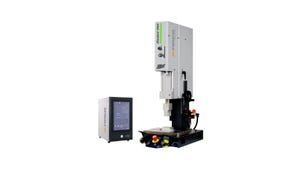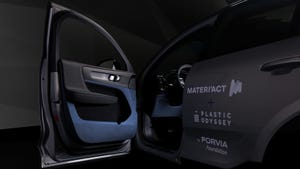Can this set of technologies elevate molding to new heights of economy and productivity? Most definitely. Will it be the answer for everyone? Not if they’re wise.
May 1, 2008
Can this set of technologies elevate molding to new heights of economy and productivity? Most definitely. Will it be the answer for everyone? Not if they’re wise. 
Playful, yet it gets the message across: This race car replica contains six parts and an IMD layer, and emerges from the mold completely assembled and decorated. The tool was created by Electroform to demonstrate the capabilities of inmold technologies.
What does it take to stay competitive these days? The question rings in the ears of most in the IM industry, while the answers aren’t quite so forthcoming. One potential candidate: a group of inmold finishing technologies that includes inmold painting, coating, cutting, assembly, multimaterial, and more are being investigated, and in some cases highly touted, as a solution to rising costs and competitive pressures.
To find out if these labor-, time-, and cost-saving strategies are the right answer for you, we’ve polled those on the leading edge of this technology area. Most all agreed that inmold technology may not be the solution for every application, but these industry insiders also told us when and why inmold finishing can be the most astute choice. We’ll also bring you up to date on where these technologies are being used.
Cavities see more action
You may recall the first time you witnessed an inmold-assembly or inmold-painting workcell in action. Perhaps you were one of the NPE 2006 attendees who flocked around the Progressive Components (Wauconda, IL) booth to see moldmaker Electroform’s exhibit, a two-shot Engel press that assembled and decorated a race car replica, all in a tool that the Rockford, IL firm built in less than eight weeks. The full development, including design and prototyping, took 17 weeks.
Even a decade ago, however, more than just molding a single part was taking place inside the cavity. Technically speaking, the first two-shot part represented the birth of inmold assembly. Shooting two materials together certainly fits the definition of the term: The part emerges finished from the mold, without the need to bond, weld, snap together, or otherwise assemble it in a secondary operation.

The car replica tool molds four tires and two body pieces in black and white ABS, assembles them by snap fit, and then decorates the body with an inmold label. Cycle time has been clocked at less than 17 seconds with an optimum press configuration.
Of course, inmold assembly that puts several parts together within the tool and uses two or more materials involves a great deal more than a relatively simple overmolding operation. But it helps to remember that complex inmold assembly grew from this technique.
Inmold decorating and labeling, known as either IML or IMD, are more familiar and older members of the inmold technology family that have found extensive proponents in automotive, packaging, and consumer goods markets.
Inmold cutting of parts that are created by backmolding onto a textile, film, or other layer is a more recent addition to the group. Think automotive door panels, for instance, or housings for consumer electronics.
When inmold assembly makes sense
Wade Clark, president and CEO at Electroform, believes there are many benefits to inmold technologies, but it’s not the easiest route. “The complexity of inmold assembly should not be underestimated,” he says, “and molders need to have a full understanding of what’s needed before undertaking projects of this nature.”
Some of the advantages of inmold assembly and other inmold processes, according to Clark, include the ability to fabricate more consistent products with better fit and performance that are not subject to warp and shrinkage issues. “Quality issues are virtually eliminated with these methods. For example, when you switch to inmold decorating or assembly, the challenge of maintaining part orientation disappears. This is not the case with secondary decoration and assembly.”
Customers who have made the switch also save money on handling, inventory, and logistics, Clark explains. Choosing a moldmaker experienced in inmold technology is critical to achieving these gains, he adds.
Moldmaker KTW Austria created this 16+16-cavity SpinStack inmold assembly tool. It creates threaded caps and corresponding spouts, complete with tamper-evident pull tabs, for food packaging applications. (Photo courtesy of Gram Technology)
Snapfit closures created via inmold assembly typically rely on two dissimilar materials that will not bond, even when molten.
What do potential adopters need to know? “Always prototype first to ensure you have chosen the right materials for your application,” he advises. “Besides proving out the product, the main reason to prototype is this—the molds and automation involved can become highly complex, and making changes to these systems can get expensive once the process is under way.”
If you’re thinking about investing in a workcell for inmold assembly, Clark says, make sure you have the orders to support that investment. “It doesn’t always have the flexibility to switch to manufacturing other types of products efficiently.”
Finally, make sure you consider the true labor cost involved. According to Clark, inmold technologies require less direct labor but more indirect labor. “While you may be able to reassign three shop floor techs as a result of an inmold project, someone has to maintain the tooling for preventive maintenance, and you’ll need highly skilled engineers that understand automation to keep the cell operating—and the time it takes to train these engineers can be underestimated.”
Ron Cisliek, sales and marketing director for Gram Technology (Scottsdale, AZ), sees interest in inmold assembly growing. “With inmold assembly comes higher part accuracy, less overall investment compared to existing approaches, less energy consumption, and it is a proven technology,” he says. “We have seen benefits in the packaging industry for caps and closures, and also in the medical market for multiple part assemblies.”
Even with the current low-growth climate in the automotive market, Cisliek reports interest from auto suppliers due to the cost savings. “It all comes down to some simple basics on why the industry is taking a hard look at the technology and that is due to cost savings, improved part quality, and more challenging product applications.”
Although it might seem that inmold-assembly molds would need tighter tolerances, it is not necessarily a mandate, according to Cisliek. “The tool is based on relationships between parts inside the mold, and performing assembly tasks in the mold reduces the number of variations that can affect the relationship of two parts coming together. This is one of the reasons that part quality improves with this technology.”
Inmold painting gains traction
UBE Machinery (Ann Arbor, MI) introduced an inmold painting system at NPE 2003 under the trade name Imprest Technology. The system relies on a low-pressure injection process similar to coining. Material is introduced into the mold and held under low pressure until it is partially cooled. The mold opens slightly and paint is sprayed onto the surface of the part. When the mold closes again, it cures the paint and ensures a Class A surface even if the part substrate is uneven. Unlike secondary painting processes, the substrate surface does not have to be perfect, only that of the mold cavity.
In December, KraussMaffei (Florence, KY) launched a system that produces LFI (long fiber injection) parts that are painted within the mold. While the LFI process does not qualify as an injection molding technology because it pours (rather than injects) molten reactive polymers, the new system does provide an option for injection molders who want to expand their product offerings. The molding sequence begins with a robotic mixing head spraying a paint layer directly onto the surface of the open, heated mold. The robot then applies a barrier coat on top of the paint layer. A separate mixing head pours the long-fiber layer, after which the mold is closed and clamped.
Harita Seating Systems Ltd. (Hosur, India) is using these systems to produce tractor engine covers that will initially be marketed in India and then exported to Europe. According to KraussMaffei, the process creates high-strength, fiber-reinforced parts with outstanding high-gloss surfaces.
For this and other inmold painting projects, pristine mold surfaces are critical to success because the paint coat is applied directly to the mold. KraussMaffei produces the molds for Harita at its Competence Center for Tooling Technologies located within the production plant in Viersen, Germany. The chief applications for these painted fiber-reinforced parts are commercial vehicles, agricultural machinery, buses, and trucks.
Multimaterials update
Perhaps the oldest of the inmold technology bunch, multimaterial molding continues to have a strong following among designers and OEMs involved in the consumer market. And this technology does more than improve a product’s aesthetic appeal.
The inmold painting process from KraussMaffei gives long-fiber components a high-gloss surface without the need for a secondary paint line.
For example, Gram Technology reports that one customer used the process to create a dialysis connector molded from two dissimilar materials that would not bond in the mold. The OEM didn’t want the materials to slide around each other, so the mold was built to sandwich them together. Half of the base material was used to make a tube, which then received a shot of TPE similar to slipping a ring on a finger. The other half of the base material was then shot on top of the TPE to encapsulate it, and included a window where the TPE material showed through. This was clearly not your father’s overmolding.
Another new twist on two-shot involves thick, heavy cosmetic jars. Gram reports that many molders are disappointed with the long cycle times required to cool the heavy base. One solution is to produce the jars as a two-shot part, shooting the same material from two different locations. The end result is that the tool runs faster and there are none of the sinks and distortion common with thick-part molding.
At Husky (Bolton, ON), business development and marketing manager for hot runners Martin Baumann believes the key to being competitive in multimaterial molding is the hot runner. “Any time you have two or more different materials and want to do more in the mold, the hot runner is the key portion of the technology,” says Baumann. “With multimaterial, the mold is already complicated, so the way to make the process efficient is to optimize the hot runner.”
No matter how many injection units you have, he explains, the system has to be able to get the polymer melt to the various injection points in a consistent way. And, he adds, “A well-executed hot runner design has a big impact on cycle time.”
When molding two or more materials with dissimilar melting points, Baumann cautions to take care that the two are thermally separated. “You don’t want one to be influenced by the other, causing burning of the lower-temperature material, splay, and other issues. A well-designed hot runner system will ensure that the materials are protected.”Keeping IML on track
Jerome Empereur, packaging market manager for Wittmann (Torrington, CT) based in France, cautions those who undertake inmold labeling and decorating projects to consider the automation as well as the IM machine. “Making sure that the labeling process is repeatable and accurate is a major contributor to success in this area,” he says.
. . . produced in this workcell designed by Wittmann . . .
IML has become popular with food packaging designers, who typically specify PP or PE labels that are compatible with the olefinic substrates. But there is still a competition between IML and offset printing, according to Empereur. “For those who would like to produce labels for different flavors of the same product, IML has an advantage in terms of cost. It is difficult to change production with offset printing, while IML requires merely loading in a different set of labels. Another concern with offset is that you need to inventory whatever is produced before shipping everything to the printing area.”
A further factor is the shape of the container itself. Round containers are usually less costly to print via offset, while IML tends to be more economical for rectangular or square shapes. “IML also enables more design freedom and better-quality images,” he adds.
What type of automation is needed for IML in this category? Many food packaging containers rely on stack molds, and Empereur suggests using a side-entry robot as long as the mold is designed to be compatible. “Side-entry stack mold automation has a high-speed axis that enters from the rear of the molding machine between the mold plates to simultaneously remove the finished parts and place the labels. Once back outside the mold, the unit hands off the parts to a stacking station and picks up new labels for the next cycle.”
. . . relies on a flexible label magazine that allows convenient refilling for different labels using the same IML robot.
In situations where there is sufficient cycle time, a top-entry robot can be used. “Often it is recommended to upsize the robot to a unit with additional payload capacity for the accuracy required for placing the labels,” he says. “This requires careful consideration to select a robot with the accuracy and speed required.”
What do you consider when designing the mold? Empereur says, “For round containers, gate at the bottom. Be sure to prevent overmolding issues, so that the label is not overmolded with the polymer. Put a feature in to lock the label in place and avoid having plastic lap over the label. Rectangular molds designed for IML are opposite to the norm. Because the label is outside the part, we have to inject inside the part with the cavity on the moving side and injection point on the fixed side. Parts are then removed from the fixed side.”
Best of Show Award
Best Part Design
Best Thin-Wall Packaging
Best IMD Durable Product
Best Label Design
Web-exclusive: IMD stunners salutedThe first annual IMDA Awards Competition acknowledged the industry’s best inmold-labeled packaging and inmold-decorated durable products. Winners were chosen based on creativity in design, engineering, and innovation, according to Ron Shultz, executive director of the Scottsdale, AZ-based In-mold Decorating Assn. Fifteen companies from North and South America, Europe, and Australia submitted a total of 34 entries in the inaugural event. And the winners were:Best of Show Award
1-kg yogurt tub
National Foods Ltd. (Australia)
Molder: VIP Packaging
The challenge in designing this innovative new Yoplait package was to use technology to differentiate the product in the marketplace. This was done through unique on-pack tamper evidence, custom-designed comfort grip, pouring spout, and stand-out, photo-quality inmold labeling.
Best Part Design
Gelato cup and lid
Wells' Dairy Inc.https://www.plasticstoday.com/Blue Bunny Brand Ice Cream & Frozen Novelties
Molder: Cups4You USA
Designers created a shape thought to be unique in the ice cream category, and the container is transparent enough to show the enticing desserts within. Jurors said the label works flawlessly with the 3D container geometry to both reflect the product's Italian heritage and maintain the Blue Bunny brand image.
Best Thin-Wall Packaging
Pasta sauce container
Olivieri Foods, div. of Canada Bread
Molder: North America IML Containers Inc.
Judges felt the containers evoked high-quality pasta sauces from a fine Italian restaurant. Five sided inmold labels in rich Italian colors allow viewing of the product below “a dramatic and elegant lid design.”
Best IMD Durable Product
Baby pacifiers
Evenflo
Graphics: IGH Solutions
Designers gave special consideration to gating, parting line, inmold label placement, and retention with this project to produce a sparkling lenticular effect. The decorated pacifiers also exemplify IMD for very small parts.
Best Label Design
Soft drink stadium cup
The Coca-Cola Co.
Label: Hammer Packaging
This cup won thanks to consistent molding without the label shifting position or wrinkling in the mold while maintaining good post-mold durability. The printing process was carefully adjusted to achieve the desired cure of the UV black background ink. The result is a dramatic presentation for the Academy Awards.WEB EXCLUSIVE: Pros of inmold assemblyRon Cisliek at Gram Technology offers a partial list of benefits that inmold assembly can provide if a part is truly qualified for the technology. Benefits are also dependent on product features and manufacturing environment:
• Smaller presses are able to be utilized with less customization
• Faster cycle times, which can be less than 8 seconds in many cases, depending on machine performance, resin type, and processing conditions
• Less energy consumption
• Less mold rotation weight = less energy and longer life of press andhttps://www.plasticstoday.com/or system
• Potential reduction of mechanics (slides, ejector systems, etc.)
• Ejection during cycle or mold opening
• Less tonnage required
• Better balance in mold and hot runner system
• Fewer ejector stroke requirements
• Allows additional operations to be performed during mold-closed portion of the cycle
• Fewer resources required to run the system
• Simple machine configurations compared to other solutions
• Improved part quality and part tolerances
• Able to run across a variety of machine manufacturers since mechanics of the system are integrated in the mold and not part of the molding machine or external automation.
• Putting an operation into a tool simplifies the IM machine requirements and reduces the need for customized machines to do the additional operation because it is in the tool.
(Pictured) A dialysis connector produced in an inmold assembly process begins with a tube molded in a rigid thermoplastic, which is then overmolded with TPE. A third shot of the same rigid material is then added to encapsulate the TPE and keep it from sliding. Gram Technology provided the tool.Electroform Co. Inc. | www.injectionmoldmaking.com
Engel | www.engelglobal.com
Gram Technology | www.gramtechnology.com
Harita Seating Systems Ltd. | www.haritaseating.com
Husky Injection Molding Systems Ltd. | www.husky.ca
KraussMaffei Technologies GmbH | www.kraussmaffei.com
Progressive Components | www.procomps.com
UBE Machinery Inc. | www.ubemachinery.com
Wittmann | www.wittmann-robot.com
About the Author(s)
You May Also Like


